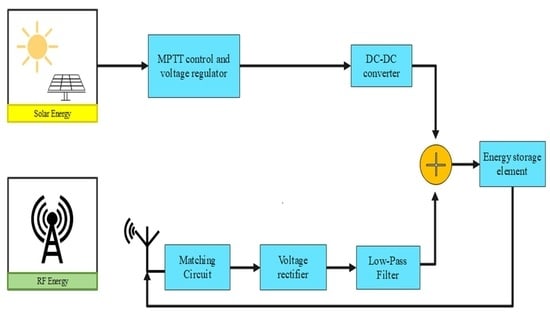A Hybrid Solar-RF Energy Harvesting System Based on an EM4325-Embedded RFID Tag
Abstract
:1. Introduction
- The proposed design system boasts remarkable mobility and is characterized by its compact form factor, making it an ideal candidate for diverse applications. The portability and miniaturization of the system also establish a noteworthy foundation for advancing sustainable and self-sufficient energy solutions in the field of RFID technology.
- The proposed unique and independent configuration offers versatility and adaptability to the system. This setup allows for optimized RF and solar energy harvesting components, potentially enhancing overall efficiency and performance.
2. Antenna Design
3. Rectifier Design
3.1. The Rectifier Principle Analysis
3.2. The RF Rectifier Measurement
4. Solar Energy Harvesting System
- = PCE;
- = Solar energy harvester PCE;
- = Input power;
- = Output power;
- = Input power from solar cell and battery.
5. Hybrid Harvesting System Measured
- = Hybrid harvester PCE
- = Combined input power from both RF and Solar energy harvesters.
- = Overall output power generated
6. Conclusions
Author Contributions
Funding
Data Availability Statement
Acknowledgments
Conflicts of Interest
References
- Lai, K.-L.; Joy, I.; Zong, C. Development of Smart Cities with Fog Computing and Internet of Things. J. Ubiquitous Comput. Commun. Technol. (UCCT) 2021, 3, 52–60. [Google Scholar]
- Yadav, P.; Vishwakarma, S. Application of Internet of Things and Big Data towards a Smart City. In Proceedings of the 3rd International Conference On Internet of Things: Smart Innovation and Usages (IoT-SIU), Bhimtal, India, 23–24 February 2018. [Google Scholar]
- Mohammed, S.K.N.K.; Alsharif, H. Energy Harvesting Techniques for Wireless Sensor Networks/Radio-Frequency Identification: A Review. Symmetry 2019, 11, 24. [Google Scholar]
- Mohammadi, A.A.-F.M. Enabling Cognitive Smart Cities Using Big Data and Machine Learning: Approaches and Challenges. IEEE Commun. Mag. 2018, 56, 94–101. [Google Scholar] [CrossRef]
- Fu, Y.; Sun, S.; Wang, Z.; Niu, P.; Zhang, M.; Chen, S.; Pang, W. Piezoelectric micromachined ultra-sonic transducer with superior acoustic outputs for pulse-Echo imaging application. IEEE Electron Device Lett. 2020, 41, 1572–1575. [Google Scholar] [CrossRef]
- Mahapatra, S.D.; Mohapatra, P.C.; Aria, A.I.; Christie, G.; Mishra, Y.K.; Hofmann, S.; Thakur, V.K. Piezoelectric Materials for Energy Harvesting and Sensing Applications: Roadmap for Future Smart Materials. Adv. Sci. 2021, 8, 1–73. [Google Scholar] [CrossRef] [PubMed]
- Liu, C.; Zhao, C.; Liu, J.; Wang, J.; Wang, Y.; Fan, Y.; Zhao, K.; Shan, B.; Qu, Z.; Ma, K.; et al. Design and study of a combining energy harvesting system based on thermoelectric and flapping triboelectric nanogenerator. Int. J. Green Energy 2021, 18, 1302–1308. [Google Scholar] [CrossRef]
- Chen, Y.; Shi, C.; Zhang, J.; Dai, Y.; Su, Y.; Liao, B.; Zhang, M.; Tao, X.; Zeng, W. Ionic Thermoelectric Effect Inducing Cation-Enriched Surface of Hydrogel to Enhance Output Performance of Triboelectric Nanogenerator. Energy Technol. 2022, 10, 2200070. [Google Scholar] [CrossRef]
- Gang, M.; Shitong, F.; Suo, W.; Shengxi, Z. A low-frequency rotational electromagnetic energy harvester using a magnetic plucking mechanism. Appl. Energy 2022, 305, 117838. [Google Scholar]
- Zhao, L.; Zou, H.; Gao, Q.; Yan, G.; Wu, Z.; Liu, F.; Wei, K.; Yang, B.; Zhang, W. Design, modeling and experimental investigation of a magnetically modulated rotational energy harvester for low frequency and irregular vibration. Sci. China Technol. Sci. 2020, 63, 2051–2062. [Google Scholar] [CrossRef]
- Muhammad, S.; Tiang, J.J.; Wong, S.K.; Smida, A.; Ghayoula, R.; Iqbal, A. A Dual-Band Ambient Energy Harvesting Rectenna Design for Wireless Power Communications. IEEE Access 2021, 9, 99944–99953. [Google Scholar] [CrossRef]
- Singh, M.; Agrawal, S.; Parihar, M.S. Design of a rectenna system for GSM-900 band using novel broadside 2 × 1. J. Eng. 2017, 2017, 232–236. [Google Scholar] [CrossRef]
- Sridhar, N.H.; Anitha, G.S.; Sumathi, M.S. Analysis of energy harvesting from multiple sources for wireless sensor networks with focus on impedance matching. In Proceedings of the 2017 International Conference on Circuit, Power and Computing Technologies (ICCPCT), Kollam, India, 20–21 April 2017. [Google Scholar] [CrossRef]
- Deo, A.; Reddy, G.S.; Arrawatia, M.; Shah, P. A Partially Transparent GSM Band Loop RF-Solar Energy Harvester. In Proceedings of the IEEE Microwaves, Antennas, and Propagation Conference (MAPCON), Bangalore, India, 12–16 December 2022. [Google Scholar]
- Omar, A.S.; Amer, A.; Imran, K.; Bong, J.C. A Hybrid Energy Harvesting Design for On-Body Internet-of-Things (IoT) Networks. Sensors 2020, 20, 407. [Google Scholar]
- Gurinder, S.; Fatima, M.; Vivek, A.B.; Anand, S. Experimental Observations on Hybrid RF-Solar Energy Harvesting Circuit for Low Power Applications. In Proceedings of the IEEE International Conference on Advanced Networks and Telecommunications Systems (ANTS), Indore, India, 16–19 December 2018. [Google Scholar]
- Sekander, S.; Tabassum, H.; Hossain, E. Statistical Performance Modeling of Solar and Wind-Powered UAV Communications. IEEE Trans. Mob. Comput. 2020, 20, 2686–2700. [Google Scholar] [CrossRef]
- Peter, T.; Rahman, T.A.; Cheung, S.W.; Nilavalan, R.; Abutarboush, H.F.; Vilches, A. A Novel Transparent UWB Antenna for Photovoltaic Solar Panel Integration and RF Energy Harvesting. IEEE Trans. Antennas Propag. 2014, 62, 1844–1853. [Google Scholar] [CrossRef]
- Muhammad, S.; Tiang, J.J.; Wong, S.K.; Smida, A.; Waly, M.I.; Iqbal, A. Efficient quad-band RF energy harvesting rectifier for wireless power communications. AEU—Int. J. Electron. Commun. 2021, 139, 153927. [Google Scholar] [CrossRef]
- Oisin, O.; Kansheng, Y.; Patrick, M.; Max, J.A. Amorphous Silicon Solar Vivaldi Antenna. IEEE Antennas Wirel. Propag. Lett. 2015, 15, 893–896. [Google Scholar]
- Sharma, P.K.; Priyanka, S.; Chamanthi, K.; Satish, A.G.; Kaushik, A.V.S. A Wide Band Meander Line Antenna for RF Energy Harvesting. In Proceedings of the 2nd International conference on Electronics, Communication and Aerospace Technology (ICECA 2018), Coimbatore, India, 39 March 2018. [Google Scholar]
- Riccardo Colella, L.C. Single-Chip Gen2-Compliant UHF RFID Sensor Tags based on Novel Pseudo-BAP Mode. In Proceedings of the 2nd URSI Atlantic Radio Science Meeting (AT-RASC), Gran Canaria, Spain, 28 May–1 June 2018. [Google Scholar]
- Pay, E.Y.; Tiang, J.J.; Muhammad, S.; Chuah, T.C. Design of an efficient solar energy harvesting system for wireless power communication. Int. J. Numer. Model. Electron. Netw. Devices Fields 2023, 36, e3054. [Google Scholar] [CrossRef]
- Isworo, P.; Retno, A.D. Characteristics Surface Temperature of Solar Cell Polycrystalline Type to Output Power. In Proceedings of the 3rd International Conference on Energy, Environmental and Information System (ICENIS 2018), Semarang, Indonesia, 21 December 2018. [Google Scholar]
- Nerat, M. Copper–indium–gallium–selenide (CIGS) solar cells with localized back contacts for achieving high performance. Sol. Energy Mater. Sol. Cells 2012, 104, 152–158. [Google Scholar] [CrossRef]
- Alessandro, R.; Elisa, A.; Daniele, M. Low substrate temperature CdTe solar cells: A review. Sol. Energy 2018, 175, 9–15. [Google Scholar]
- Schropp, R.E.; Carius, R.; Beaucarne, G. Amorphous Silicon, Microcrystalline Silicon, and Thin-Film Polycrystalline Silicon Solar Cells. MRS Bull. 2007, 32, 219–224. [Google Scholar] [CrossRef]
- Dullweber, T.; Schmidt, J. Industrial Silicon Solar Cells Applying the Passivated Emitter and Rear Cell (PERC) Concept—A Review. IEEE J. Photovolt. 2016, 6, 1366–1381. [Google Scholar] [CrossRef]
- Muhammad, S.; Waly, M.I.; AlJarallah, N.A.; Ghayoula, R.; Negm, A.S.; Smida, A.; Iqbal, A.; Tiang, J.J.; Roslee, M. A multiband SSr diode RF rectifier with an improved frequency ratio for biomedical wireless applications. Sci. Rep. 2023, 13, 13246. [Google Scholar] [CrossRef] [PubMed]
- Dahmane, A.; Gianfranco, A.V.; Yvan, D.; Rachida, T. Harmonic Power Harvesting System for Passive RFID Sensor Tags, Smail Tedjini. IEEE Trans. Microw. Theory Tech. 2016, 64, 2347–2356. [Google Scholar]
- Jadhav, S.B.; Lambor, S.M. Hybrid Solar and Radio Frequency (RF) Energy Harvesting. In Proceedings of the IEEE International Conference on Power, Control, Signals and Instrumentation Engineering (ICPCSI), Chennai, India, 21–22 September 2017. [Google Scholar]
- Ankita, D.; Shrikanth, R.G.; Mahima, A.; Prashant, S. A Patch Rectenna Fed with L-probe to Harvest Solar and RF Energy. In Proceedings of the IEEE Microwaves, Antennas, and Propagation Conference (MAPCON), Bangalore, India, 12–16 December 2022. [Google Scholar]
- Muhammad, S.; Waly, M.I.; Mallat, N.K.; AlJarallah, N.A.; Ghayoula, R.; Negm, A.S.; Smida, A.; Iqbal, A. Wideband RF rectifier circuit for low-powered IoT wireless sensor nodes. AEU-Int. J. Electron. Commun. 2023, 170, 154787. [Google Scholar] [CrossRef]
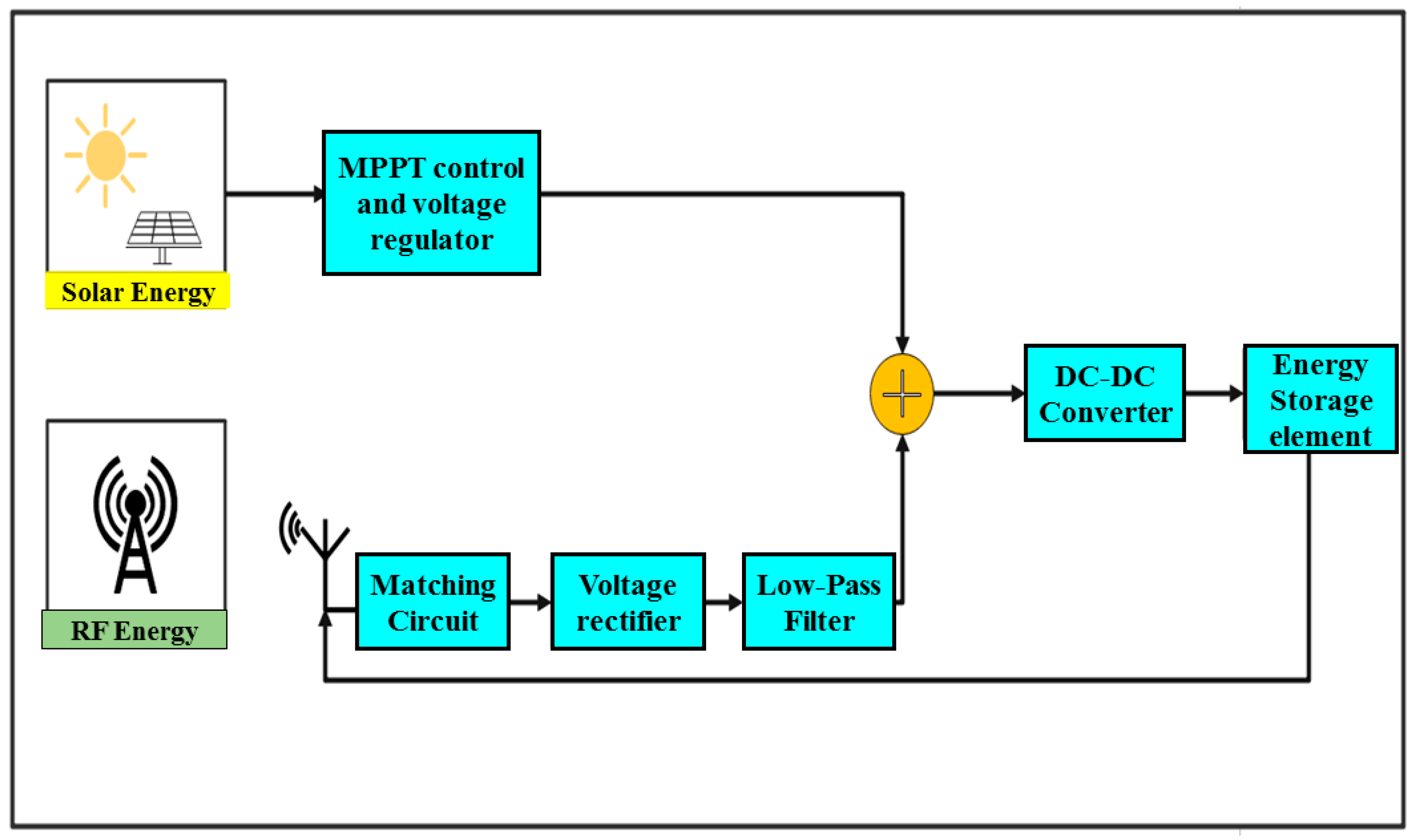

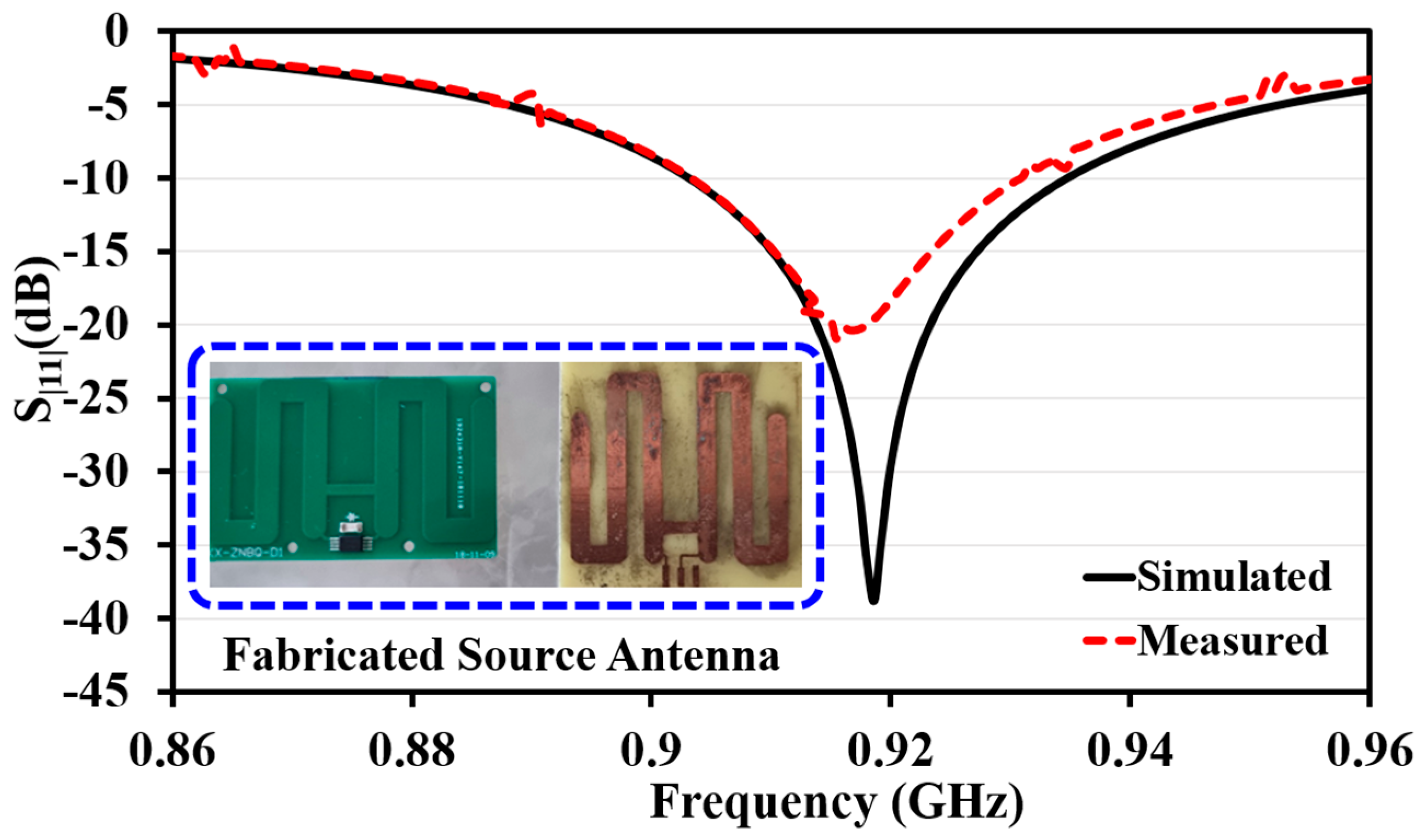

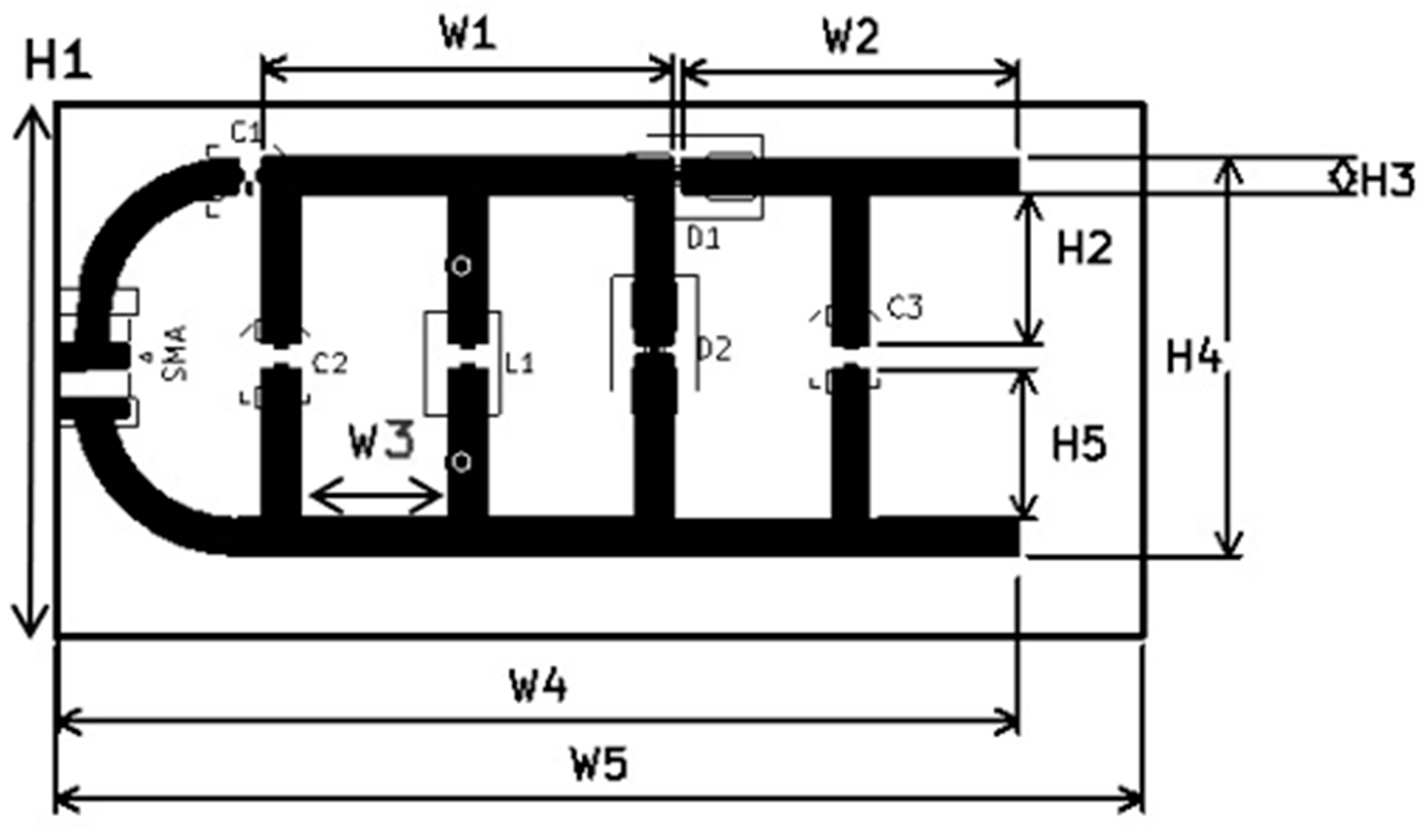
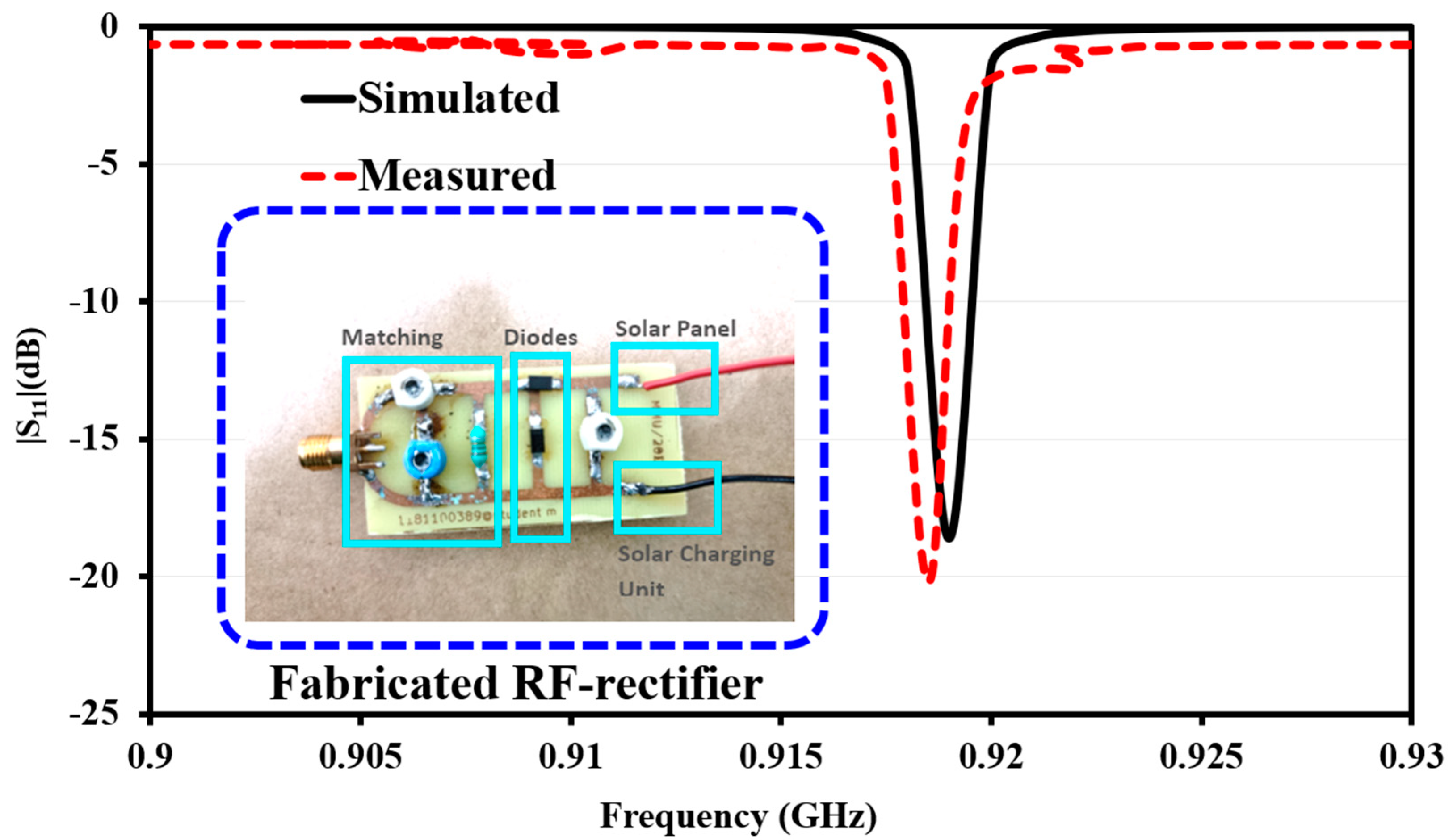


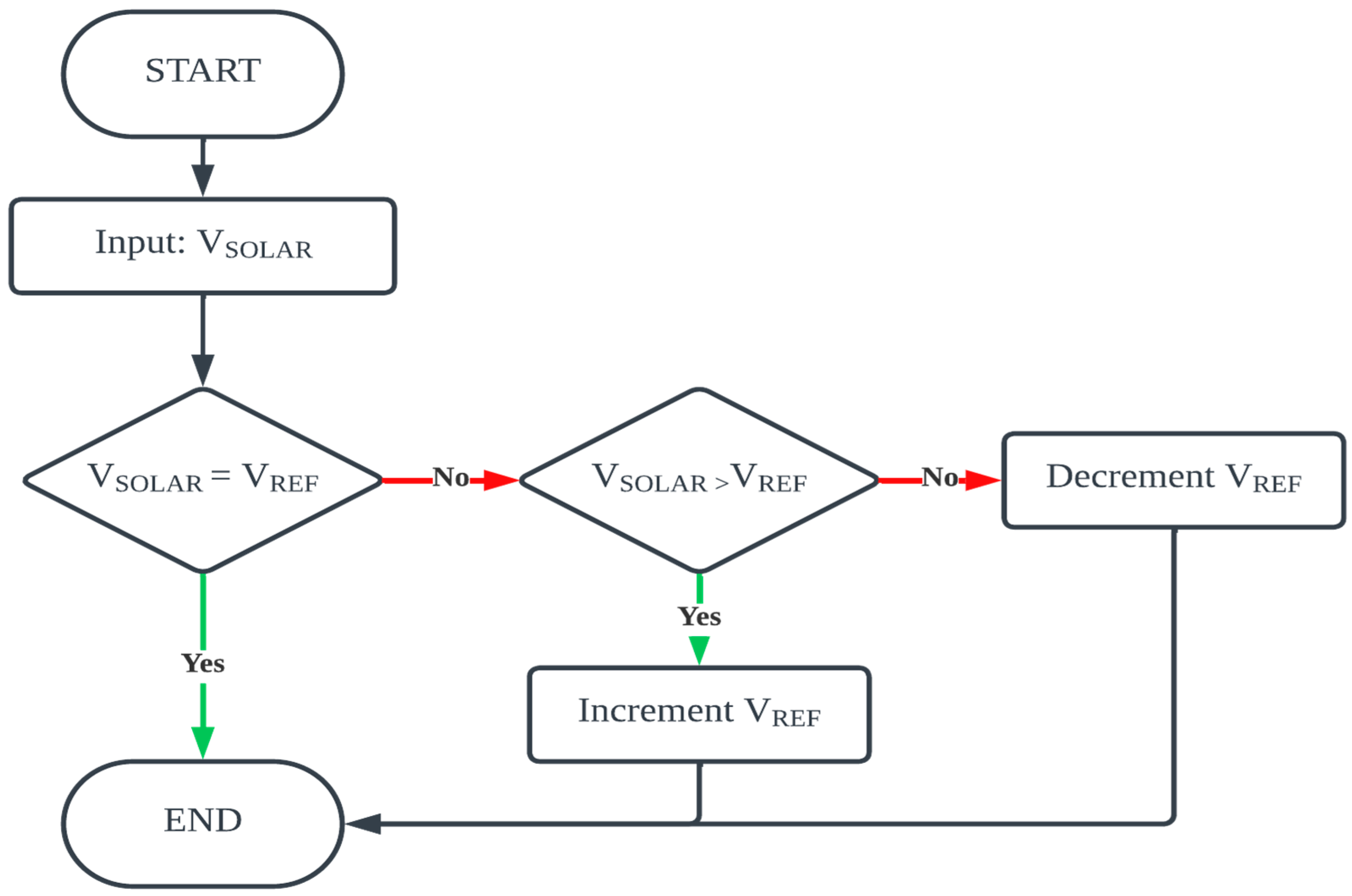
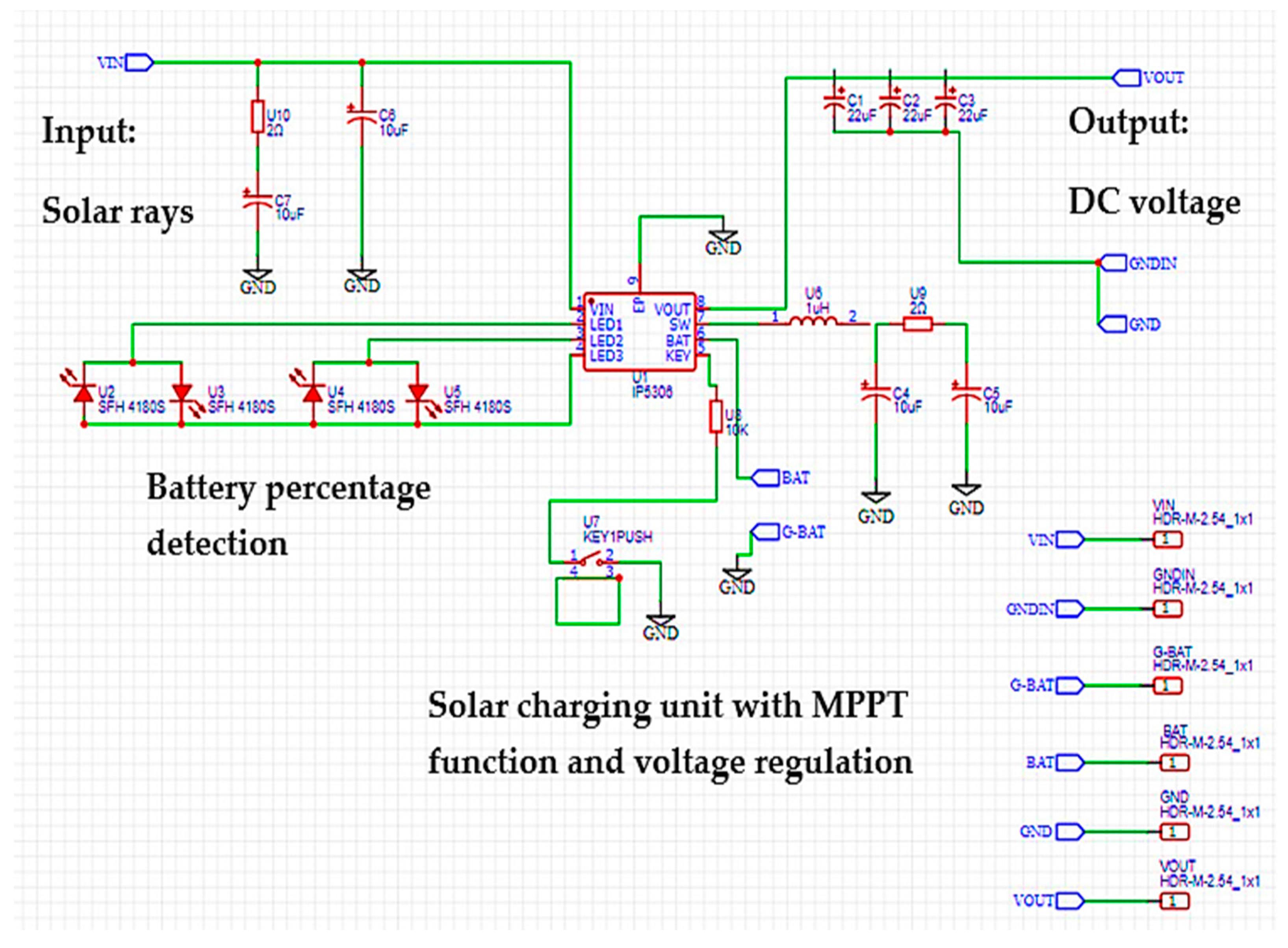


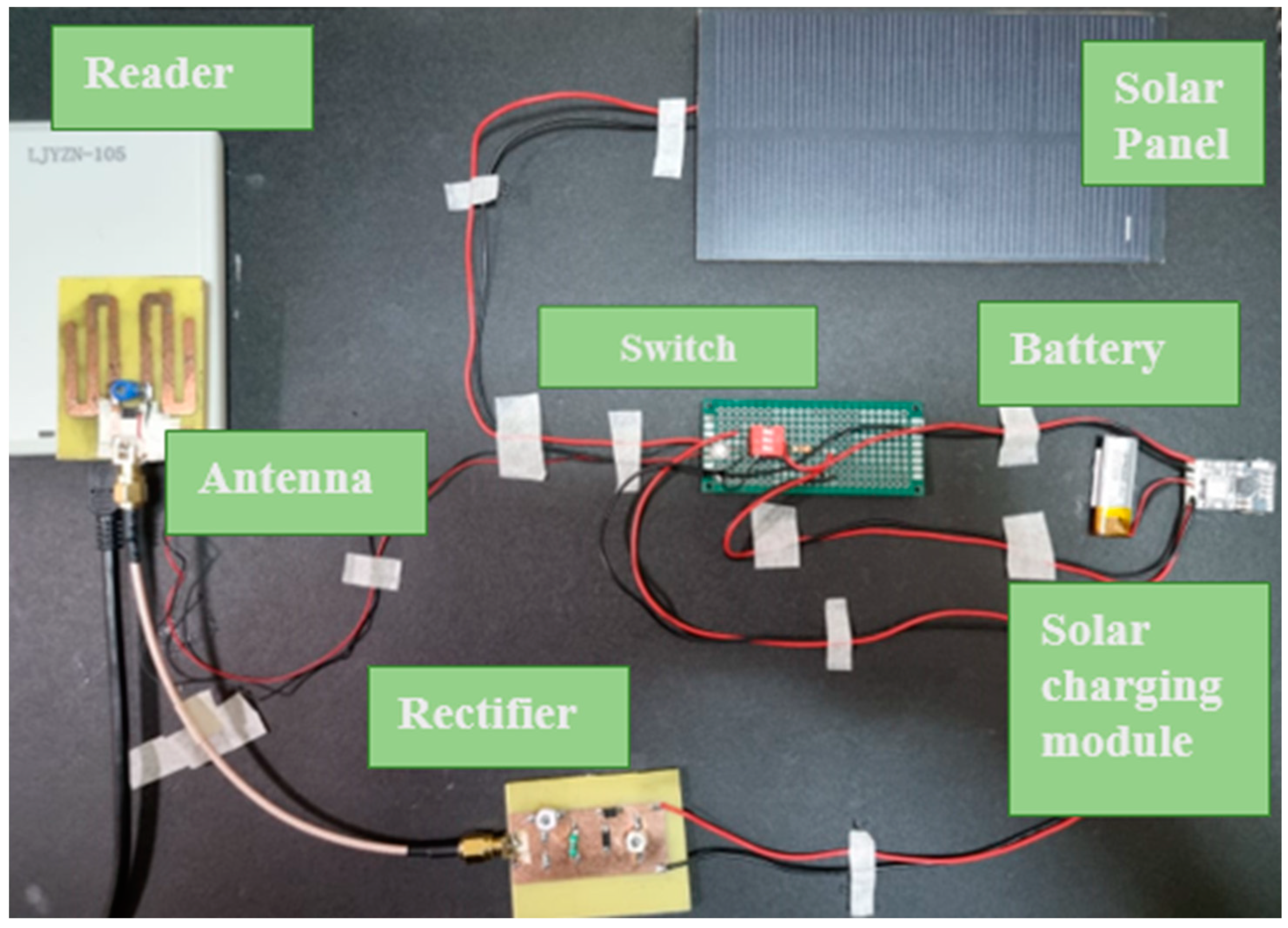
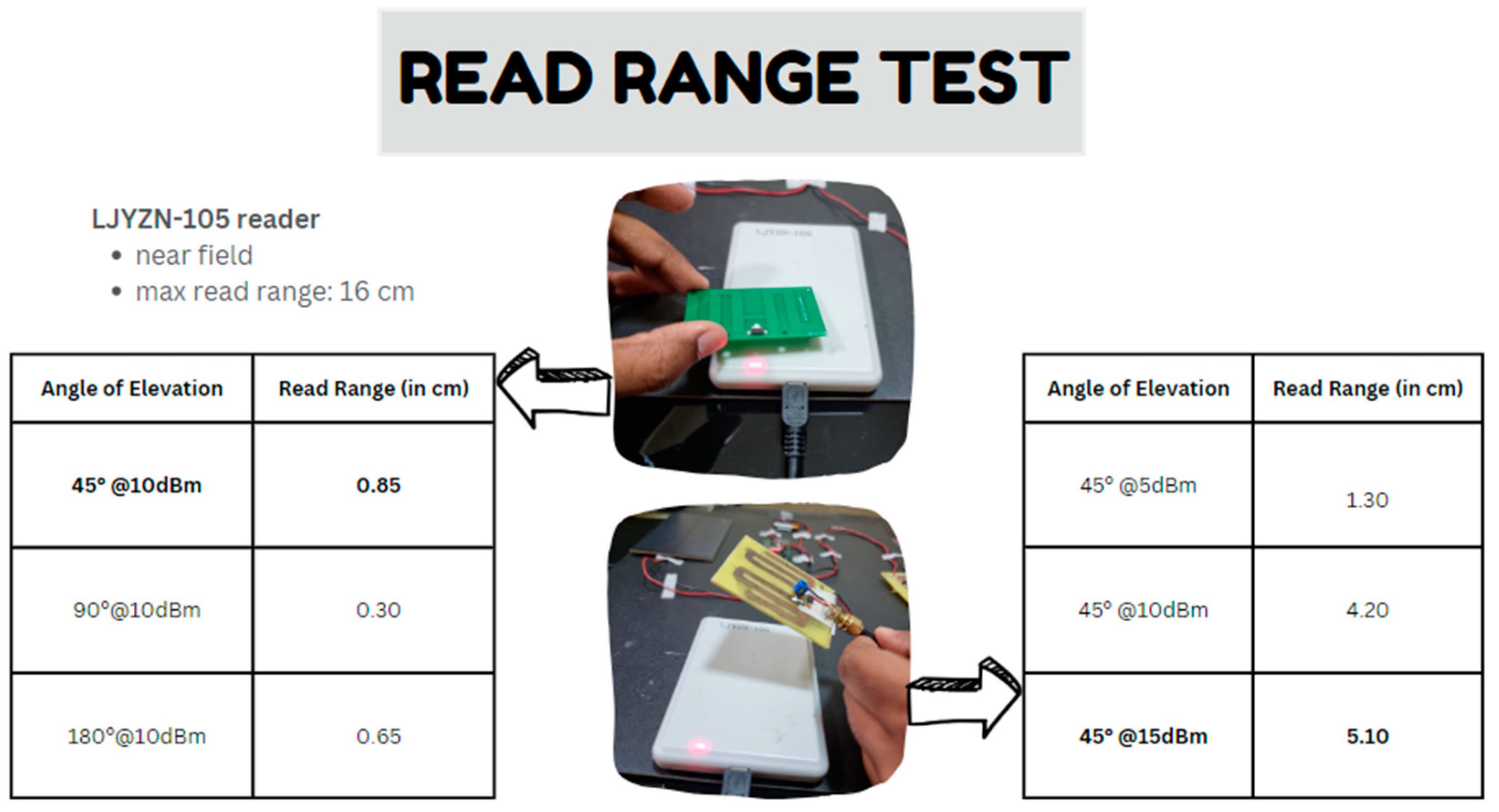

| Parameters | Value (mm) | Parameters | Value (mm) |
|---|---|---|---|
| W1 | 2.73 | W9 | 45.72 |
| W2 | 2.73 | H1 | 1.75 |
| W3 | 8.19 | H2 | 55.34 |
| W4 | 43.25 | H3 | 36.58 |
| W5 | 45.72 | H4 | 28.78 |
| W6 | 2.73 | H5 | 55.34 |
| W7 | 6.85 | 4.65 | |
| W8 | 2.73 | T1 | 1.6 |
| Parameters | Value (mm) | Title 2 | Title 3 |
|---|---|---|---|
| W1 | 20.96 | H1 | 27.18 |
| W2 | 17.15 | H2 | 7.26 |
| W3 | 5.86 | H3 | 1.91 |
| W4 | 49.07 | H4 | 20.32 |
| W5 | 55.48 | H5 | 7.26 |
| Type | Efficiency | Pros | Cons |
|---|---|---|---|
| Silicon: | |||
| Monocrystalline | <20% | Space-efficient Longer lifespan Produced from non-toxic material High power capacity Perform better in low-light conditions | Expensive Heavily reliant on weather The pure silicon that is cut into wafer shapes produces significant waste in the manufacturing stage |
| Polycrystalline | 15–17% | Affordable No efficiency recession Ease of fabrication onto cheap substrates Work well at high temperatures ranging from 90 to 122 degrees Fahrenheit [24] | Affordable Lower heat tolerance In terms of energy conversion and space utilization, these PV cell technologies exhibit lower efficiency. |
| Thin film: | |||
| Copper indium gallium selenide (CIGS) [25] | 13–15% | High efficiency due to high absorption rate High temperature coefficient, better for hotter environments | Low efficiency Encapsulation problems as they are susceptible to damage by moisture |
| Cadmium telluride (CdTe) [26] | 9–11% | Low-cost With the lowest carbon footprint, minimal water requirement, and shorter energy payback time, they showcase superior ecological characteristics. | The toxic nature of cadmium makes recycling more expensive Heavy in weight as it is manufactured with glass substrate |
| Amorphous silicon (a-Si) [27] | 6–8% | Silicon does not possess a molecular-level structure. It only necessitates a small fraction of the silicon required for conventional silicon cells. It is well-suited for systems with low power requirements. | Very short lifespan Lower power generation by solar panels |
| Passivated Emitter and Rear Contact (PERC) [28] | 5% | It enables the collection of more solar energy within a reduced physical space. It offers a lower average cost per watt of electrical energy produced. | Fragile and susceptible to damage High purchasing cost Tend to lose their efficiency with each passing year due to potential induced degradation and light-induced degradation. |
| (W) | (V) | (A) | (W) | (%) |
|---|---|---|---|---|
| 1.538 | 5.50 | 0.174 | 0.9601 | 62.43 |
| 1.845 | 5.46 | 0.219 | 1.1939 | 64.71 |
| 2.367 | 5.39 | 0.300 | 1.6188 | 68.39 |
| 2.538 | 5.36 | 0.344 | 1.8420 | 72.58 |
| 2.991 | 5.30 | 0.431 | 2.2830 | 76.33 |
| 3.520 | 5.26 | 0.526 | 2.7646 | 78.54 |
| 3.767 | 5.21 | 0.580 | 3.0211 | 80.20 |
| 4.106 | 5.17 | 0.630 | 3.2581 | 79.35 |
| 4.419 | 5.08 | 0.614 | 3.1189 | 70.58 |
| 4.986 | 5.03 | 0.657 | 3.3067 | 66.32 |
| Work | Harvester | DC Output | PCE (%) |
|---|---|---|---|
| [16] | Dual-band inverted-F antenna GSM 900 and GSM 1800 | 0.747 V @ −30 dBm | 12.93% for 0.9 GHz @ −30 dBm 8.0% for 1.8 GHz |
| [14] | Broadband loop rectenna attached with solar panel | 120.416 μW @ −10 dBm | 45.6% @ −10 dBm |
| [29] | Two-element microstrip patch antenna @ 900 MHz | RF:26 μW @ −10 dBm Solar:2.35 @ −10 dBm Hybrid:2.36 @ −10 dBm | RF:26.01% @ −10 dBm Solar:81.22% @ −10 dBm Hybrid:81.39% @ −10 dBm |
| [30] | Single port quad-band antenna integrated with solar panel 0.82 GHz to 2.4 GHz | 0.707 V @ −20 dBm | 48% @ −20 dBm |
| [31] | EM4325 meander tag @ 900 MHz | 39 μW @ −22 dBm | 45% @ −22 dBm |
| [32] | A patch antenna integrated with solar panel @ 2.4 GHz | 9 W @ 16 dB | - |
| [33] | Wideband RF rectifier @ 1.74 GHz–2.93 GHz | 0.6 V @ 3 dBm | 75.80 % @ 3 dBm |
| This work | Meander line RFID tag @ 919 MHz Stub-matching transmission line −6 W solar panel and ESOP8 solar charging module | RF:2.04 V @ 12 dBm Solar:3.021 W @ 10 dBm Hybrid: 3.92 W @ 15 dBm | RF: 55.14% @ 12 dBm Solar:80.20% @ 10 dBm Hybrid: 86.49% @ 15 dBm |
Disclaimer/Publisher’s Note: The statements, opinions and data contained in all publications are solely those of the individual author(s) and contributor(s) and not of MDPI and/or the editor(s). MDPI and/or the editor(s) disclaim responsibility for any injury to people or property resulting from any ideas, methods, instructions or products referred to in the content. |
© 2023 by the authors. Licensee MDPI, Basel, Switzerland. This article is an open access article distributed under the terms and conditions of the Creative Commons Attribution (CC BY) license (https://creativecommons.org/licenses/by/4.0/).
Share and Cite
Veloo, S.G.; Tiang, J.J.; Muhammad, S.; Wong, S.K. A Hybrid Solar-RF Energy Harvesting System Based on an EM4325-Embedded RFID Tag. Electronics 2023, 12, 4045. https://doi.org/10.3390/electronics12194045
Veloo SG, Tiang JJ, Muhammad S, Wong SK. A Hybrid Solar-RF Energy Harvesting System Based on an EM4325-Embedded RFID Tag. Electronics. 2023; 12(19):4045. https://doi.org/10.3390/electronics12194045
Chicago/Turabian StyleVeloo, Samrrithaa G., Jun Jiat Tiang, Surajo Muhammad, and Sew Kin Wong. 2023. "A Hybrid Solar-RF Energy Harvesting System Based on an EM4325-Embedded RFID Tag" Electronics 12, no. 19: 4045. https://doi.org/10.3390/electronics12194045
APA StyleVeloo, S. G., Tiang, J. J., Muhammad, S., & Wong, S. K. (2023). A Hybrid Solar-RF Energy Harvesting System Based on an EM4325-Embedded RFID Tag. Electronics, 12(19), 4045. https://doi.org/10.3390/electronics12194045






